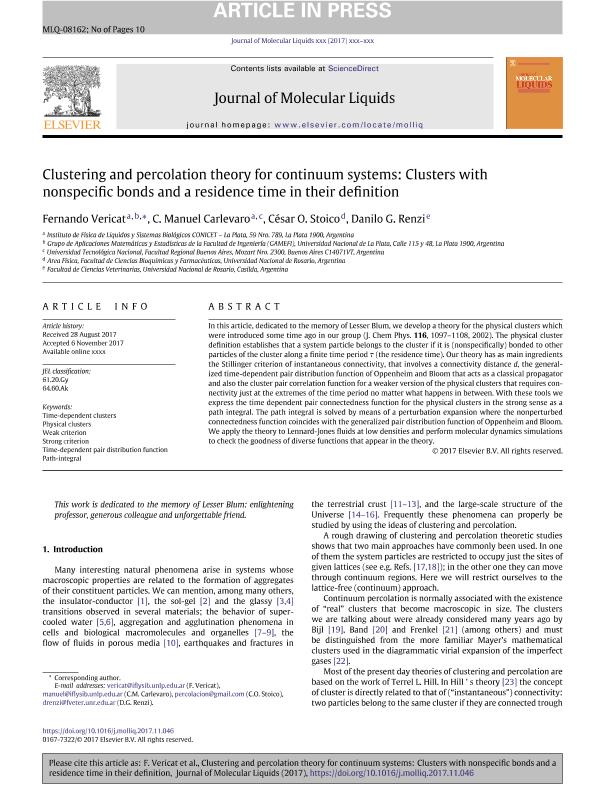Artículo
Clustering and percolation theory for continuum systems: Clusters with nonspecific bonds and a residence time in their definition
Fecha de publicación:
11/2017
Editorial:
Elsevier Science
Revista:
Journal of Molecular Liquids
ISSN:
0167-7322
Idioma:
Inglés
Tipo de recurso:
Artículo publicado
Clasificación temática:
Resumen
In this article, dedicated to the memory of Lesser Blum, we develop a theory for the physical clusters which were introduced some time ago in our group (J. Chem Phys. 116, 1097–1108, 2002). The physical cluster definition establishes that a system particle belongs to the cluster if it is (nonspecifically) bonded to other particles of the cluster along a finite time period τ (the residence time). Our theory has as main ingredients the Stillinger criterion of instantaneous connectivity, that involves a connectivity distance d, the generalized time-dependent pair distribution function of Oppenheim and Bloom that acts as a classical propagator and also the cluster pair correlation function for a weaker version of the physical clusters that requires connectivity just at the extremes of the time period no matter what happens in between. With these tools we express the time dependent pair connectedness function for the physical clusters in the strong sense as a path integral. The path integral is solved by means of a perturbation expansion where the nonperturbed connectedness function coincides with the generalized pair distribution function of Oppenheim and Bloom. We apply the theory to Lennard-Jones fluids at low densities and perform molecular dynamics simulations to check the goodness of diverse functions that appear in the theory.
Archivos asociados
Licencia
Identificadores
Colecciones
Articulos(IFLYSIB)
Articulos de INST.FISICA DE LIQUIDOS Y SIST.BIOLOGICOS (I)
Articulos de INST.FISICA DE LIQUIDOS Y SIST.BIOLOGICOS (I)
Citación
Vericat, Fernando; Carlevaro, Carlos Manuel; Stoico, César Omar; Renzi, Danilo Germán; Clustering and percolation theory for continuum systems: Clusters with nonspecific bonds and a residence time in their definition; Elsevier Science; Journal of Molecular Liquids; 270; 11-2017; 128-137
Compartir
Altmétricas




